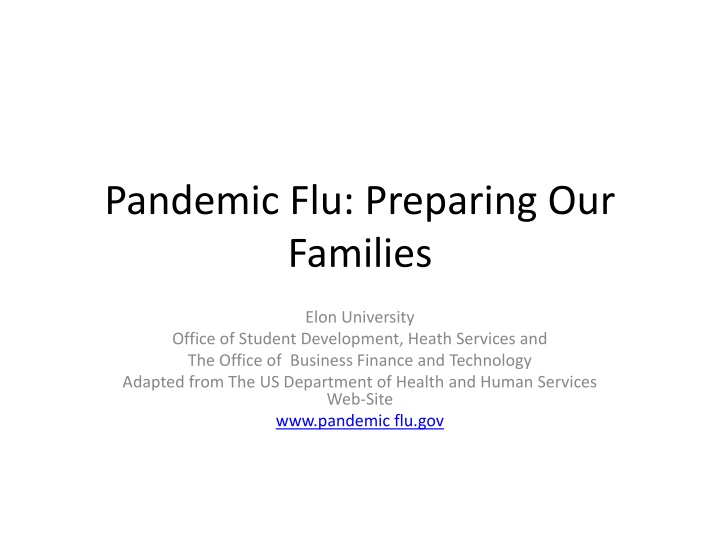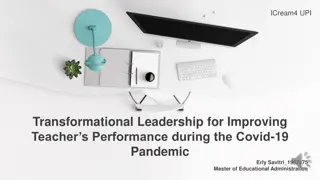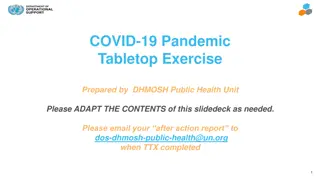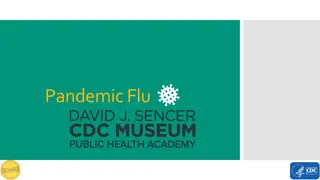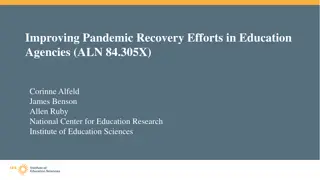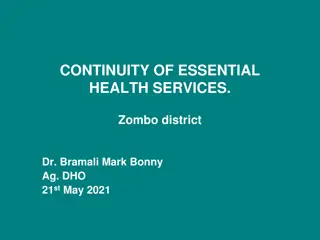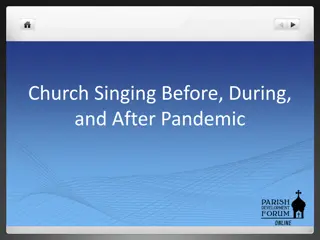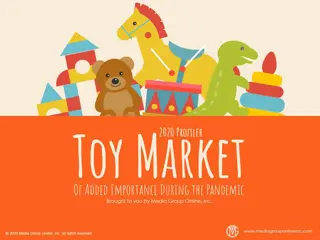Preparing Your Family for a Pandemic: Tips & Guidelines
Effective preparation for a pandemic flu outbreak involves storing essential supplies, developing a care plan for family members, and maintaining a healthy lifestyle. Tips include storing water and food, checking prescription drugs, and practicing good hand hygiene. The best defense against any illness is leading a healthy, balanced lifestyle. Prevention strategies such as handwashing, covering coughs and sneezes, and staying home when sick are emphasized to reduce the spread of infections.
Download Presentation

Please find below an Image/Link to download the presentation.
The content on the website is provided AS IS for your information and personal use only. It may not be sold, licensed, or shared on other websites without obtaining consent from the author.If you encounter any issues during the download, it is possible that the publisher has removed the file from their server.
You are allowed to download the files provided on this website for personal or commercial use, subject to the condition that they are used lawfully. All files are the property of their respective owners.
The content on the website is provided AS IS for your information and personal use only. It may not be sold, licensed, or shared on other websites without obtaining consent from the author.
E N D
Presentation Transcript
Pandemic Flu: Preparing Our Families Elon University Office of Student Development, Heath Services and The Office of Business Finance and Technology Adapted from The US Department of Health and Human Services Web-Site www.pandemic flu.gov
Preparing Your Family for A Pandemic Our families are important to us! Planning for all types of emergencies (including a flu pandemic) will help us better navigate and lessen the effects of an emergency.
Tips for pandemic flu planning These tips can be useful in other types of emergencies, such as power outages and disasters. Store a two week supply of water and food. During a pandemic, if you cannot get to a store, or if stores are out of supplies, it will be important for you to have extra on hand. Periodically check your regular prescription drugs to ensure a continuous supply in your home. Have any nonprescription drugs and other health supplies on hand, including pain relievers, stomach remedies, cough and cold medicines, fluids with electrolytes, and vitamins. Develop a care plan for members of your family. Talk with family members and loved ones about how they would be cared for if they got sick, or what will be needed to care for them in your home.
The Best Defense for Any Illness is to Lead a Healthy, Balanced Lifestyle Eat a balanced diet. Be sure to eat a variety of foods, including plenty of vegetables, fruits, and whole grain products. Also include low-fat dairy products, lean meats, poultry, fish, and beans. Drink lots of water and go easy on salt, sugar, alcohol, and saturated fat. Maintain A Healthy Weight Exercise on a regular basis and get plenty of rest. Follow your doctor s orders if you have a pre- existing or chronic condition
Prevention is the Best Medicine Practice good hand hygiene by washing your hands often with soap and water, especially after coughing or sneezing. Alcohol-based hand cleaners are also effective. Cover your mouth and nose with a tissue when you cough or sneeze. If you don t have a tissue, cough or sneeze into your elbow or shoulder; not into your hands. Stay home or at your place of residence if you are sick for at least 24 hours after you no longer have a fever (100 degrees Fahrenheit or 38 degrees Celsius) or signs of a fever (have chills, feel very warm, have a flushed appearance, or are sweating). This should be determined without the use of fever-reducing medications (any medicine that contains ibuprofen or acetaminophen). Staying away from others while sick can prevent others from getting sick too. Ask a roommate, friend, or family member to check up on you and to bring you food and supplies if needed. Consult with University Health Services if you are sick and must stay home from class. Talk to your health care provider to find out if you should be vaccinated for seasonal flu and/or 2009 H1N1 flu. Information about 2009 H1N1 flu vaccination can be found at: www.cdc.gov/h1n1flu/vaccination. Information about seasonal flu vaccine can be found at: www.cdc.gov/flu/protect/keyfacts.htm. Check E-Net for vaccine administration dates on campus.
Symptoms of H1N1 The symptoms of novel H1N1 flu virus in people include fever (100 or above), cough, sore throat, runny or stuffy nose, body aches, headache, chills and fatigue. A significant number of people who have been infected with this virus also have reported diarrhea and vomiting. Severe illnesses and death has occurred as a result of illness associated with this virus.
Why is Planning important?
Service Disruption May Be Widespread Due to Staffing Shortages Plan for the possibility that usual services may be disrupted. These could include services provided by hospitals and other health care facilities, banks, stores, restaurants, government offices, and post offices. Municipal services (Power and water) may also be affected due to staffing shortages Consider how to care for people with special needs in case the services they rely on are not available.
Being Able to Work May Be Difficult or Impossible You may be home sick with a loved one or yourself Develop a plan for your office that provides for operation of essential services in the event many of you are out at one time. You will receive more information about out leave polices in the coming weeks if we have an outbreak on campus
Schools May Be Closed for an Extended Period of Time Consider childcare needs. Plan home learning activities and exercises. Have materials, such as books, on hand. Also plan recreational activities that your children can do at home.
Transportation Services May Be Disrupted Think about how you can rely less on public transportation during a pandemic. For example, store food and other essential supplies so you can make fewer trips to the store. Prepare backup plans for taking care of loved ones who are far away. Consider other ways to get to work.
People Will Need Advice and Help at Work and Home Have at least a general knowledge of your institutions emergency preparation plan Think about what information the people in your workplace will need if you are a manager. Meet with your colleagues and make lists of things that you will need to know and what actions can be taken. Identify other information resources in your community, such as mental health hotlines, public health hotlines, or electronic bulletin boards for support and information. Find support systems people who are thinking about the same issues you are thinking about. Share ideas.
Develop A Family Emergency Health Information Sheet Including Family Member Blood Type Allergies Past/ Current Medical Conditions Current Medications/ Dosages For example go to: http://www.pandemicflu.gov/plan/indi vidual/familyhealthinfo.html
Emergency Health Information Sheet Family Member Blood Type Allergies Past/ Current Medical Conditions Current Medications/ Dosages Jana Fields O pos. none none none Patterson John Michael Patterson B neg peanuts none Aspirin 81 mg/daily Gregory John Patterson B neg Bee stings none none
Develop An Emergency Contact Plan Contacts Name/Phone Number Local personal emergency contact Ronald A. Klepcyk (336) XXX- XXXX Out-of-town personal emergency contact Ashley and Chuck Wile (803) XXX-XXXX Hospitals near: Work Alamance Regional Medical Center School Alamance Regional Medical Center Home Alamance Regional Medical Center Family physician(s) Burlington Family Practice (336) XXX-XXXX State public health department (See list on www.pandemicflu.gov/state/statecontacts.ht ml) Pharmacy CVS (336) XXX-XXXX Employer contact and emergency Jana- Elon University (336) 278-5555
Be Prepared Stock a supply of water and food. During a pandemic you may not be able to get to a store due to illness. Even if you can get to a store, it may be out of supplies. Public waterworks services may also be interrupted. Stocking supplies can be useful in other types of emergencies, such as power outages and disasters. Store foods that: are nonperishable (will keep for a long time) and don't require refrigeration are easy to prepare in case you are unable to cook require little or no water, so you can conserve water for drinking (plan for 1 gallon per person per day)
Emergency Supplies Cleansing agent/soap Bleach Flashlight Batteries Portable radio Manual can opener Garbage bags Tissues, toilet paper
Nonperishable Food Supplies Bottled water Electrolyte Drinks (Gatorade, PowerAde) Ready-to-eat canned meats, fish, fruits, vegetables, beans, and soups Include broth based soups in case someone becomes ill Protein or fruit bars Dry cereal or granola Peanut butter or nuts Dried fruit Crackers Canned or boxed juices Canned or jarred baby food and formula Other non-perishable items
Medical Supplies and Medication Supply of prescription medications Medicines for fever, such as acetaminophen or ibuprofen Thermometer Anti-diarrheal medication Vitamins Fluids with electrolytes (Gatorade, PowerAde , Pedialyte) Surgical gloves Surgical Masks
If you have Babies and Children, Dont Forget Formula and additional water to prepare formula Disposable bottles Diapers Wipes Children s Fever Reducers Children s Anti-Diarrheal Children s Electrolyte fluids (Pedialyte)
Dont Forget Pets Pet Foods Kitty Litter
Phasing In Your Supplies Purchase basic emergency supplies as soon as you can- If you already have them on hand, put in a centralized place and make sure your family knows how to access them. For food and other non-perishables, add a few extra items to your weekly shopping until you have the supplies in place. Use your supplies in your regular rotation and replenish them in your weekly shopping.
What to Do if You are Ill If not an emergency, stay home and self-isolate if you are ill and follow the CDC s recommendations . Faculty and staff members who are ill should consult with their dean, department chair or supervisor as soon as possible. We anticipate faculty and staff may also need to stay home to attend to a loved one in their household who is ill. We suggest that teaching faculty evaluate their syllabi for flexibility in the event of personal illness or illness in their household which requires their care-giving. The Center for the Advancement of Teaching and Learning (CATL) is developing resources for faculty and teaching staff which may address some of your questions regarding courses. You will receive an e-mail in the next few days about accessing these resources. We may also experience multiple absences in administrative and service departments due to illness. Administrative and support area supervisors should develop plans for on- going operations in the event there are multiple absences in their offices or departments. Can you share phone and reception duties? Faculty and staff may also utilize the phone triage strategies to assist them in determining whether they should self-isolate. Of course, faculty and staff can always come to Health Services according to personnel procedures ($10.00 co-pay) during operational hours for evaluation and treatment. There is also a physician s assistant available for faculty and staff free on Thursday mornings in the Employee Wellness Building by Arts West. Plans are being made for daily phone contact with ill students, faculty, and staff members who have been triaged at Heath Services throughout the duration of their isolation period to check on medical well-being.
Who is most at risk? Illness with the new H1N1 virus has ranged from mild to severe. While most people who have been sick have recovered without needing medical treatment, hospitalizations and deaths from infection with this virus have occurred. About 70 percent of people who have been hospitalized with this novel H1N1 virus have had one or more medical conditions previously recognized as placing people at high risk of serious seasonal flu-related complications. This includes pregnancy, diabetes, heart disease, asthma and kidney disease. Anyone with a condition that puts them at high risk should consult their medical provider at the first sign of illness!
Interesting Information for older citizens One thing that appears to be different from seasonal influenza is that adults older than 64 years do not yet appear to be at increased risk of novel H1N1-related complications thus far. CDC laboratory studies have shown that no children and very few adults younger than 60 years old have existing antibody to novel H1N1 flu virus; however, about one-third of adults older than 60 may have antibodies against this virus. It is unknown how much, if any, protection may be afforded against novel H1N1 flu by any existing antibody.
How long are people contagious? People infected with seasonal and novel H1N1 flu shed virus and may be able to infect others from 1 day before getting sick to 5 to 7 days after. This can be longer in some people, especially children and people with weakened immune systems and in people infected with the new H1N1 virus. Do not resume normal activities until you have been fever-free (less than 100 degrees) for 24 hours without fever reducers
Emergency Warning Signs In children, emergency warning signs that need urgent medical attention include: Fast breathing or trouble breathing Bluish or gray skin color Not drinking enough fluids Severe or persistent vomiting Not waking up or not interacting Being so irritable that the child does not want to be held Flu-like symptoms improve but then return with fever and worse cough
Emergency Warning Signs In adults, emergency warning signs that need urgent medical attention include: Difficulty breathing or shortness of breath Pain or pressure in the chest or abdomen Sudden dizziness Confusion Severe or persistent vomiting Flu-like symptoms improve but then return with fever and worse cough
Vaccines We expect to have regular seasonal flu vaccine available in late October. Watch e-mail ad E-Net. Supplies are limited. The University does plan to administer vaccines to students, faculty and staff when it becomes available. We will follow protocols established by state health authorities. More information will follow. Check e-mail and watch E-Net.
Stay Informed But Calm Knowing the facts is the best preparation. Identify sources you can count on for reliable information. If a pandemic occurs, having accurate and reliable information will be critical. E-Net is the best resource for accurate information about Elon s Emergency Response Plans. Reliable, accurate, and timely information is available at www.pandemicflu.gov. Another source for information on pandemic influenza is the Centers for Disease Control and Prevention (CDC) Hotline at: 1-800-CDC- INFO (1-800-232-4636). This line is available in English and Spanish, 24 hours a day, 7 days a week. TTY: 1-888-232-6348. Questions can be e-mailed to cdcinfo@cdc.gov. Look for information on your local and state government Web sites. Links are available to each state department of public health at www.cdc.gov/other.htm#states. Listen to local and national radio, watch news reports on television, and read your newspaper and other sources of printed and Web- based information. Consult your health care providers, especially if you have a chronic medical condition which places you in a high risk category. As you begin your individual or family planning, you may want to review your state's planning efforts and those of your local public health and emergency preparedness officials. Many of the state plans and other planning information can be found at pandemicflu.gov/plan/state/index.html.
Where Can I Get More Information? These and other resources are available on the Health Services Web-site at http://www.elon.edu/e- web/students/health_services/ Check e-mail and E-Net This PowerPoint presentation will also be available on the web-site as well for further review.
